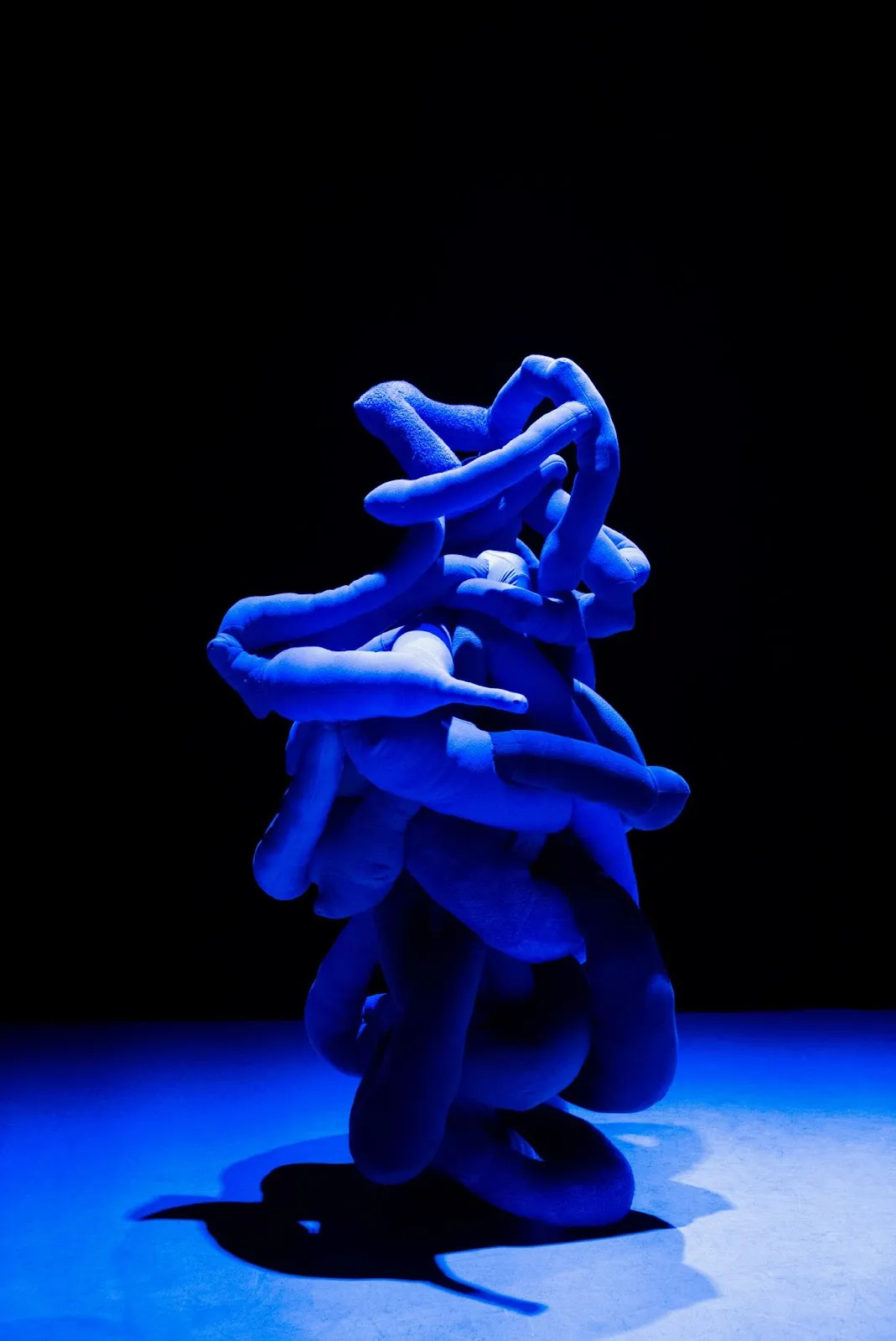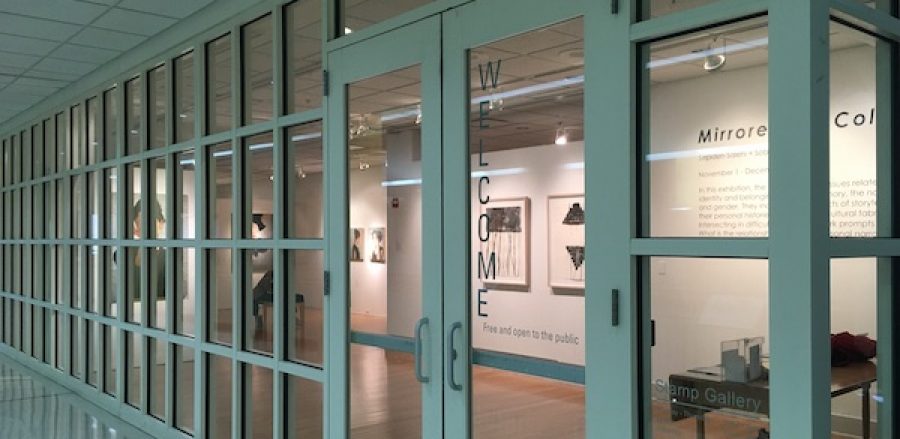Questioning Individualism
Posted: April 1, 2024 Filed under: Current Exhibition | Tags: Charlotte Richardson-Deppe, Contemporary Art, I Resist This, soft sculpture, stamp gallery, UMD, University of Maryland Leave a commentI Resist This from March 4th to April 6th, 2024 at The Stamp Gallery | University of Maryland, College Park | Written by Rachel Schmid-James
Visual art has become an individualistic art form over the last few hundred years, but it has not always been this way. Before it was considered an independent task, it was a way to bind communities together. Art has always been a part of humanity, and from the very start it has been a group project. Some of the first examples we have of humans creating art are cave paintings created thousands of years ago. These simple paintings involved everybody in the community; even the youngest children would be lifted to the ceiling to add their handprints to the walls. However, at some point down the line, industrialization in the Western world made us pull away from communal values in search of individualism. This dichotomy can be seen in soft sculptor and performance artist Charlotte Richardson-Deppe’s work: independence and togetherness have their own positive and negative aspects. She uses her performances to explore the idea of community; asking us why we are all so afraid to ask for help, and why we are so desperate to break away from each other in the first place.

Richardson-Deppe discusses this concept in an interview with writer Charlee Dryoff as it relates to her past, present, and future projects. In her sister works titled Yellow and Blue, these struggles are front and center. In Yellow, two performers twist together in a multi-person bodysuit that attaches them at their arms and legs. While they can still move their torsos and heads freely, they have to work together to walk, fighting against each other as they do so. In contrast, Blue costumes a single person who is enrobed in ropes of blue fabric. While they are protected from the outside world and the tensions which appear in Yellow, the wearer is completely isolated and restricted by the garment. Richardson-Deppe explains that these two works are meant to represent that “both connection and loneliness have benefits and hardships.” One must sometimes choose whether to be safe from stress and tension with others but be totally alone, or to be with others and struggle to win back the independence that society has told us to crave. As seen in examples such as the cave paintings, humans are communal creatures that are meant to lean on each other for help and support. This does not mean that the struggle for independence is not valid, but it does make you question why you want independence so badly in the first place. Richardson-Deppe shows that she also struggles with these concepts, but says that she is challenging them through the simple act of asking for help. “Asking for help is profound, vulnerable, necessary, and we all should be doing it more often,” Richardson-Deppe says. “It is also reciprocal—I will help you hang your exhibition, and you will help me film my performance. I will carry your sculpture and you will proofread my application.” As in Yellow and Blue, her new performance I Resist This, which will be performed at the Stamp Gallery on April 6, shows the value of asking. The final performance will include multiple performers all attached by the same soft sculpture. They will have to rely on each other and help pull one another, but their tension and resistance will make it difficult to do this. It is hard to accept support when everything around us suggests weakness, but Richardson-Deppe asks the audience to think deeper and take that first step towards a more supportive way of being.

Charlotte Richardson-Deppe’s work is included in I Resist This at The Stamp Gallery of the University of Maryland, College Park, from March 4th to April 6th, 2024. Richardson-Deppe end her artist residency with a performance of I Resist This on April 6th, 2024 at 7pm. For more information on Richardson-Deppe, visit https://www.charlotte-rd.com/. For more information on I Resist This and related events, visit https://stamp.umd.edu/centers/stamp_gallery.
Exploring Independence and Interdependence Through I Resist This
Posted: March 27, 2024 Filed under: Current Exhibition, Top Picks! | Tags: art, Charlotte Richardson-Deppe, I Resist This, soft sculpture, stamp gallery, UMD, University of Maryland Leave a commentPlaceholder from March 4 to April 6, 2024 at The Stamp Gallery | University of Maryland, College Park | Written by Ellen Zhang
The conflict of independence versus interdependence has always been a silent yet prominent theme in human life. From a young age, we crave independence with stubborn I-can-do-everything-by-myself attitudes that continue into our adulthood. However, humans are fundamentally social creatures, relying on the people around us to achieve some sense of fulfillment. Expressions of independence and interdependence often manifest in intriguing ways. Charlotte Richardson-Deppe explores this concept through her evolving, interactive exhibition, I Resist This, where she utilizes the Stamp Gallery as a workspace to complete her new work of soft sculpture performance.
One way in which Richardson-Deppe reveals the tension between independence and interdependence is by sewing together shirts and pants, which are then hung from the ceiling. The laws of physics are clearly at play: gravity and suspension create a state of equilibrium. Gravity pulls the fabric downwards whereas the parts connected to the ceiling pull the fabric upwards. As a result, the collective string of shirts or pants remains stable and motionless. However, when we look closer at the individual shirts and pants, there is an evident struggle. An individual piece strives to break free while surrounding pieces pull it closer to the complete assemblage. There’s a delicate balance in effect. The independent bodies depend on each other to counter gravity but, at the same time, are individually struggling for autonomy. Through this, Richardson-Deppe captures the essence of independence versus interdependence perfectly: the intricate dance between individuality and interconnectedness within a collective fabric of humanity.
One of the standout pieces in Richardson-Deppe’s exhibition is her piece “Pants with Friends”. Here, the medium between the indigo leggings and blue velour pants is a different fabric cut: an arm sleeve. The sleeve acts as a conduit through which new perspectives, experiences, and emotions flow. This shows how the connecting force between two individuals enriches their separate lives.
What’s particularly intriguing about Richardson-Deppe’s exhibition is its interactiveness. Her exhibition consists of wearables to be worn and presented as elements of interactive performances. The purpose is to facilitate conversations on interdependence and care. Richardson-Deppe’s exhibition helps us recognize dependency as a necessity but not at the expense of individuality. Dependent relationships enrich our lives—think of the people we call mentors, confidants, and lifetime supporters. At the same time, Charlotte’s work reminds us that freedom and autonomy are important. In fact, we care more about setting boundaries and cultivating healthy relationships when these desires are embraced.
I Resist This is a space to explore the tensions between autonomy and reliance and how individual freedom is necessary to care for ourselves and others. By presenting her work as interactive performances featuring performers and audience members, Richardson-Deppe is actively practicing community engagement, which is fundamentally interdependent. By expressing independence versus interdependence in her exhibition and actively practicing it in the culminating performance, she invites us to ponder our roles within communities and the dynamics of relationships.
